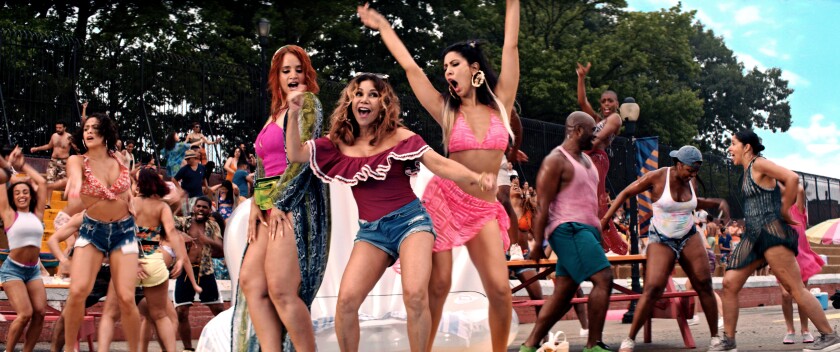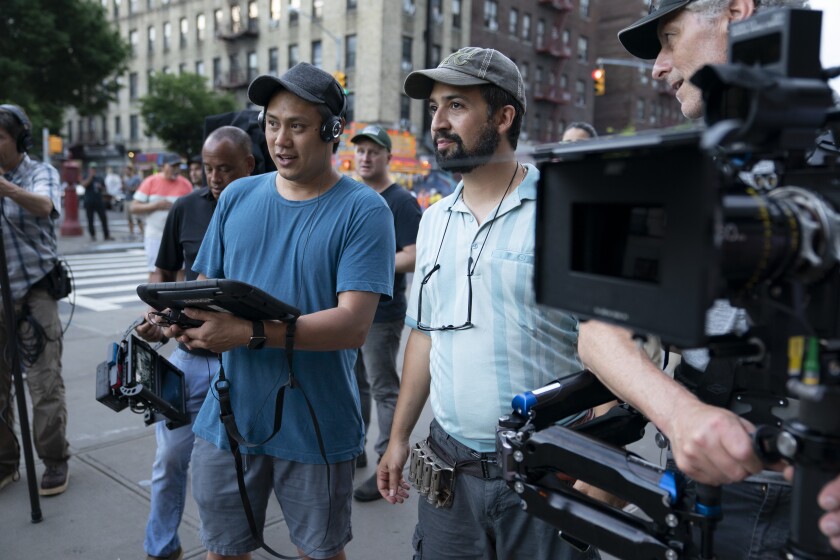If you love the stage version of “In the Heights,” the Tony Award-winning musical by Lin-Manuel Miranda, brace yourself — there are some pretty big changes in the movie version. Beloved songs are missing (including (gasp!) “Everything I Know”), plot lines are condensed, and one character (Camila Rosario) is completely axed.
But Miranda doesn’t want anyone to freak out about it.
“There are die hard fans who are like, ‘HOW COULD YOU?’” Miranda says during a recent interview. “And I take that as a badge of pride because it means they are so connected to the stage version and can’t imagine the movie without it. That makes me really happy. I’ve also had way more time to process those losses, so I get it. You’re allowed to be sad that your favorite song isn’t in the movie.”
And, really, he adds, the story remains the same. The scores of those missing songs are even scattered throughout the movie, so you can still hear parts of them in instrumental form.
“In the Heights” is about the dreams and struggles of the people living in Washington Heights, a predominantly Latino neighborhood in the northernmost part of Manhattan. There’s the main character, Usnavi (Anthony Ramos), who longs to return to the Dominican Republic. Vanessa (Melissa Barrera) dreams of moving, too, but just a couple dozen blocks downtown. Benny (Corey Hawkins) wants to open his own business in a neighborhood that’s quickly gentrifying. Abuela (Olga Merediz) wants to win the lottery. And Nina (Ariana Greenblatt), the pride of the Heights, the one who “made it out,” isn’t fitting in at Stanford the way she imagined.
And, yes, while there may be changes to the “In the Heights” universe, translating the story to the big screen actually enhances it.
“It reclaims the genre of a movie musical,” says Daphne Rubin-Vega, who plays salon owner Daniela in the film. “Sometimes, turning a stage musical into a film can by iffy and limiting, but this movie throws that idea on its ear. It uses the genre to be even more expansive and to tell a story in a way that a regular film could never do.”

Corey Hawkins (center) as Benny in Warner Bros. Pictures’ “IN THE HEIGHTS,” a Warner Bros. Pictures release.
(Warner Bros. Pictures/Courtesy of Warner Bros. Pictures)
In the film, you’re able to get a true sense of Washington Heights, from its neighborhood bodegas and spontaneous block parties to its stifling heat and crowded apartments. At the same time, the movie is able to infuse elements of magic, plus dance numbers that are so big and vibrant, they can barely be contained on a big screen.
“There’s something about this film, and that it was made in Washington Heights not a sound stage ... it truly captures reality,” says Rubin-Vega. “You can’t replicate a sunset in Washington Heights, at least, I don’t think you can.”
Bringing Rubin-Vega to the world of “In the Heights” is another point in favor of the film.
She’s a veteran Broadway actress who originated the role of Mimi in “Rent” and who also originated the role of Beatriz in “Miss You Like Hell,” a musical that premiered at the La Jolla Playhouse in 2016.
Though she doesn’t often step into roles that have already been created, Rubin-Vega says she was given the freedom to play the role of Daniela in her own way.
“My Daniela has a bit of a Napoleonic thing going on,” she explains. “She’s like the high priestess, wherever there’s a problem, she goes there. She’s a self-sufficient woman and she’s fiercely protective of the things she loves, the people she loves, and her very own joy. She’s also the embodiment of a legacy of Black and Latina women who set up a shop to take care of the hair of their people.”

Caption: (Center l-r) Dascha Polanco as Cuca, Daphne Rubin-Vega as Daniela and Stephanie Beatriz as Carla in Warner Bros. Pictures’ “In the Heights,” a Warner Bros. Pictures release.
(Warner Bros.)
Having this ability to reshape her character isn’t something she would have been able to do if she took over the role on Broadway, where once a character is set you have to do things the way the actor before you did it.
“I think that’s a shortcoming of theater in particular,” she says. “Very rare is the instance where you get to recreate and reimagine a role, so I’ve been very lucky to be able to do that. My hats off to people who can pour their physical instrument into something that someone else originated, that’s a special, specific skill that not everyone can do.”
There have actually been various incarnations of Daniela, and of pretty much every character in “In the Heights.”
Miranda first staged a version of the musical in 2000, when he was a sophomore at Wesleyan University in Connecticut. Soon after that, he teamed up with writer Quiara Alegría Hudes and director Thomas Kail and together they crafted and re-wrote the story that eventually went to Broadway and won the Tony for Best Musical in 2008.
So when film director Jon M. Chu asked if the creative team could rewrite the “Blackout” song, which comes at a pivotal point in the story, Miranda didn’t even hesitate to say yes.
“Jon was a little awestruck about that,” laughs Miranda. “But I’ve rewritten these songs so many f—ing times. Because we did the hardest thing first, we wrote an original musical. You’re supposed to adapt something first, have something with a spine that tells you the songs go here, here and here. But that first iteration of ‘In the Heights,’ every time we wrote a song, the plot would change — it was like a 12-sided Rubik’s Cube.
So when we’re talking about the screen version and Jon is asking, I’m like ‘OK, I’ll rewrite it.’ And he’s like, ‘Whaaat?’ I’ve rewritten this song so many times. Every time I’ve changed a thing, I have to rewrite the blackout. So, it’s actually not a big deal for me to rewrite the blackout. I have, like, 20 versions of the blackout.”

Lin-Manuel Miranda and director Jon M. Chu.
(Warner Bros.)
Another reason Miranda is easily able to rewrite songs is because he still lives in the same neighborhood where he grew up, the same neighborhood that inspired the show in the first place. Miranda says everywhere he goes, the blocks are layered with memories that come rushing back just by walking by a certain park, store or subway line.
“I can’t watch ‘Paciencia Y Fe’ in our movie without thinking of the summer of 2004, when my summer job to pay rent was playing theater games with the kids who had failed the fourth grade test in Woodhaven, Queens,” he says. “I would stop in the Drama Book Shop and write for an hour every day on my way to work and back, and that’s how ‘Paciencia Y Fe’ got written — every little hour I could spare as a break in my hour and a half commute to work.”
Still, for anyone who longs for the stage version of “In the Heights” that they’ve known and loved for the last decade, Miranda says to think of it as two different entities, the way he does with “Cabaret.”
In “Cabaret,” Herr Schultz and Fräulein Schneider are in the stage version, but not the film.
“Those are two characters I adore from the stage version of ‘Cabaret,’” he says. “I don’t think about them when I watch the movie, and I’m always happy to see them when I see the show again. We didn’t burn the original libretto of ‘In the Heights,’ it’s OK you’ll still see everyone again.”
"stage" - Google News
June 10, 2021 at 08:00AM
https://ift.tt/3gsBZPg
'In the Heights' isn't exactly like the stage version, and that's a good thing - pacificsandiego.com
"stage" - Google News
https://ift.tt/2xC8vfG
https://ift.tt/2KXEObV
Bagikan Berita Ini















0 Response to "'In the Heights' isn't exactly like the stage version, and that's a good thing - pacificsandiego.com"
Post a Comment